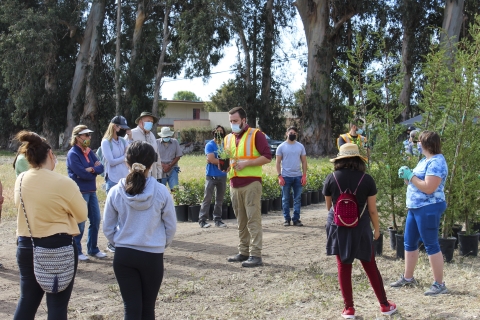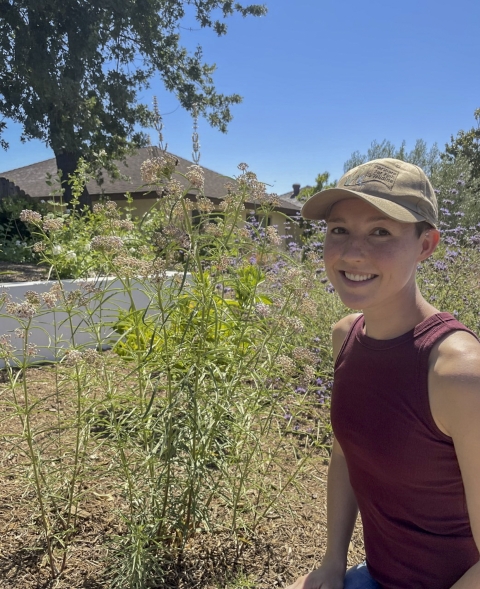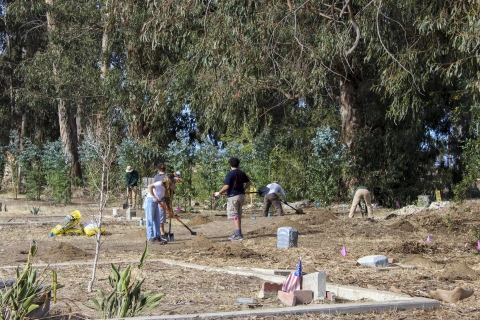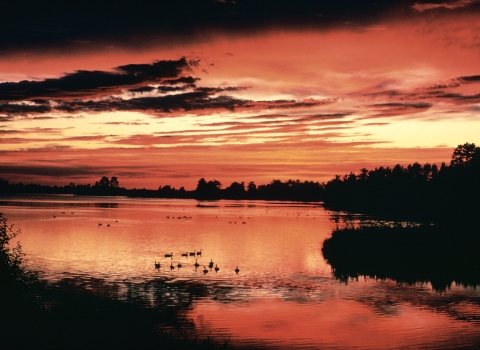By Ventura Fish & Wildlife Office public affairs
Mary Teague, Partners for Fish and Wildlife Program coordinator for the U.S. Fish and Wildlife Service began working with the Ventura County Resource Conservation District and private landowners in 2020 to restore and enhance three monarch butterfly overwintering groves in Ventura and Santa Barbara counties.
The Monarch Species Status Assessment identifies the loss, senescence and incompatible management of overwintering sites in California as one of the primary drivers of the decline of the western population.
“Monarchs are most vulnerable during the overwintering and breeding stages of migration, which makes the preservation and enhancement of these sites incredibly important in increasing the western monarch population,” said Teague.
This project funds the development of site-specific habitat management plants for three overwintering groves in Oxnard, Carpenteria and Santa Barbara, California. The quality of an overwintering site depends on the very local microclimates driven by the forest canopy. Detailed analysis revealed that none of the sites had optimal microhabitat conditions to support monarch overwintering.
Teague and the Partners Program worked with the Conservation District and private landowners to implement the restoration activities described in each site-specific habitat management plan to improve microhabitat conditions. This work includes removing fallen trunks and invasive plants, revegetating the sites through planting native, pesticide-free California nectar sources with bloom times correlated with monarch breeding cycles, planting trees and shrubs to provide several layers of wind protection, and installing irrigation systems and browsing protection to ensure plant success.
“There is also a strong community outreach component to these restoration projects,” said Teague. “The VCRCD has done an excellent job recruiting volunteers and ensuring that the community is involved in these efforts.”
We sat down with Teague to ask her a few questions about her work to help western monarchs and find out why she’s so passionate about pollinator conservation.
Q: What drives your passion for pollinator conservation? Is there a personal connection you’d like to share?
A: I believe that biodiversity is the greatest natural resource that we have, and it is important to protect it. I am driven to a career in conservation because in my lifetime, it has become normal to disregard the fact that species all around the world are going extinct at record rates, and I refuse to sit back and watch. Pollinators are incredible indicators of biodiversity and the overall health of an ecosystem. Currently, monarch butterflies are my main focus when it comes to pollinator conservation because of their recent population decline and my proximity to their overwintering locations in coastal California. Monarchs are considered an umbrella species, which means that protecting them also provides protection to many other species. Through my work in the Partners Program, I have been able to directly prioritize and support monarch and pollinator restoration projects. I am committed to continue doing this work because it would be devastating to witness the disappearance of any species, and certainly the disappearance of a charismatic, iconic species such as the monarch would hurt that much more. I am inspired by the commitment of my project partners, and I believe that if we work together then we can do great things in the name of pollinator conservation.
Q: What would you like others to know about your pollinator conservation efforts?
A: Our pollinator conservation efforts are just getting started! This restoration project is the first of many projects to come to enhance and restore overwintering, breeding and migratory habitat for monarchs and other pollinators on the California’s Central Coast. The Partners Program is continuing to work with the Ventura County RCD and many other partners to leverage funding and create a landscape level project to support monarchs and pollinators at every stage in their life cycle. The Habitat Assessments and Restoration for Monarchs – Overstory and Nectar Enhancement and Expansion Project (HARMONEE), also known as the Ventura County Monarch Flyway Project, is in development now. The project has four goals, 1) protect, manage and restore monarch overwintering sites, 2) restore breeding and migratory habitat, 3) protect monarchs and their habitat from pesticides, and 4) increase community education and outreach opportunities.
This project will support migrating monarchs and pollinators by reducing flying distances between foraging and breeding sites by increasing and diversifying the necessary nectar resources available. The sites chosen for the project are distributed across Ventura County throughout neighboring cities and unincorporated communities, ensuring that monarchs and pollinators have abundant sources of seasonally suitable habitat when traveling through the County. I want folks to know that the local partners California’s south-central coast are connected and motivated to do good work for pollinators.
Q: What is something you enjoyed doing as part of this project?
A: I really enjoyed working alongside community members and volunteers to implement restoration activities at the Hueneme Masonic Cemetery in Oxnard, California. There was a fantastic turnout of volunteers from the community and that really showed me how invested folks are in the effort to prevent the extinction of the western monarch population. There was something particularly special about this event, as it had far reaching impacts aside from the overwintering habitat restoration component – it also was an opportunity to beautify and restore the historic cemetery site. Hueneme Masonic Cemetery (est. 1898) was neglected for about 50 years until the current owner purchased the property in 2014 and began clean-up and restoration efforts. The landowner has a goal to transform the site into a place where the community can gather, enjoy the monarchs, pay their respects to those buried there and feel connected to one another. Representatives from the Coastal band of the Chumash Nation also participated in the event to ensure that no cultural resources were disturbed through our planting efforts. Overall, the event was a tremendous success and I enjoyed spending time with everyone as we got our hands dirty!
Q: Where can people find out more information about your project?
A: People can find more information about this project by checking out the Monarch Regional Advisory Committee site on the Ventura County RCD’s website: https://www.vcrcd.org/mrac.






